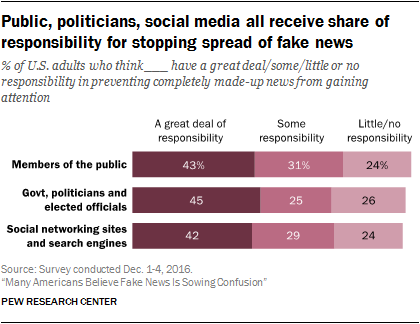New Pew Report: Majority Of Americans Across Party Lines Say Fake News Caused “A Great Deal” Of Confusion
Written by Brennan Suen
Published

According to a new Pew Research report, 64 percent of Americans -- including a majority in both political parties -- said that fake news has caused “a great deal” of confusion about the basic facts of current events.
According to the study, the fake news problem is a bipartisan one: “Republicans and Democrats are about equally likely to say that these stories leave Americans deeply confused about current events”:
While fake news became an issue during the highly charged 2016 presidential election campaign, Republicans and Democrats are about equally likely to say that these stories leave Americans deeply confused about current events. About six-in-ten Republicans say completely made-up news causes a great deal of confusion (57%), and about the same portion of Democrats say the same (64%). And although independents outpace Republicans (69% say fake news causes a great deal of confusion), they are on par with Democrats. This perception is also mostly consistent across education, race, gender and age, though there is some difference by income.
These findings draw a sharp contrast between Americans’ perception of fake news and an active campaign by right-wing media and figures, including Donald Trump and his transition team, to downplay the existence of these false stories and attack credible news sources by blurring the lines between fake news (fabricated information presented as a legitimate news story) and real reporting. Fox host Sean Hannity called concerns about fake news “nonsense,” and conservative radio host Rush Limbaugh, attempting to make fake news a partisan issue, called it “satire and parody that liberals don’t understand.” Similarly, The Washington Free Beacon’s Bill McMorris described fake news as “whatever people living in the liberal bubble determined to be believed by the right.” Trump himself tried to undermine CNN’s reporting on his executive producer credit on NBC’s Celebrity Apprentice by calling it “FAKE NEWS!” And Trump transition senior advisor and former campaign manager Kellyanne Conway asserted that “the most fake piece of news” during the election was that Trump couldn’t win.
The report also found that Americans “collectively assign a fairly high and roughly equal amount of responsibility” for the spread of fake news to three groups: social networking sites and search engines, government and politicians, and members of the public. The survey reported that 42 percent of U.S. adults believe that social networking sites like Facebook and search engines like Google have “a great deal of responsibility” in “preventing completely made-up news from gaining attention.”

Though Google and Facebook have announced steps to combat the spread fake news, including the policy Google adopted in November barring fake news publishers from using its advertising system, a Media Matters analysis found that Google AdSense-linked advertisements were still running on countless hyperpartisan websites peddling fake news nearly a month later. Ad revenue is a driving cause of the fake news explosion and incentivizes its spread. On Facebook, large, hyperpartisan pages that regularly peddle fake news content still remain verified.

According to the report, nearly a quarter of Americans admitted to sharing a fake news story that they either knew at the time was made up or later found out was fake. Nearly one-third of U.S. adults reported seeing fake political news online “often,” and 71 percent reported seeing fake political news at least sometimes.

Pew’s report comes just two days after PolitiFact named fake news the “2016 lie of the year” and about a month after the election, which saw engagement on Facebook with top fake news stories surpass engagement with top news stories from 19 major news outlets.
Image created by Sarah Wasko.